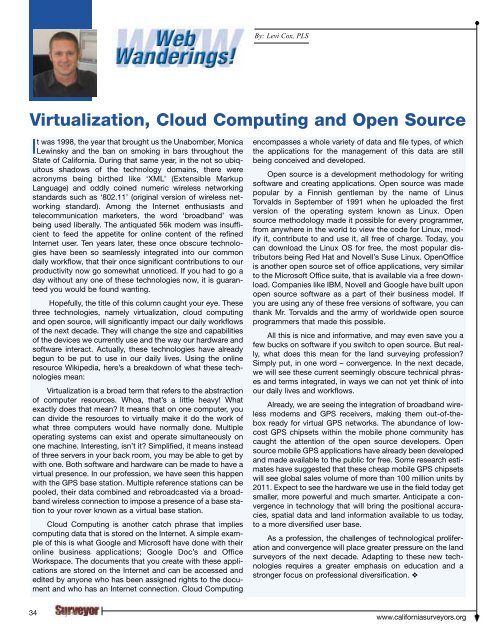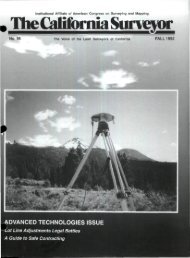CHANGE SERVICE REQUESTED The California Surveyor ... - CLSA
CHANGE SERVICE REQUESTED The California Surveyor ... - CLSA
CHANGE SERVICE REQUESTED The California Surveyor ... - CLSA
You also want an ePaper? Increase the reach of your titles
YUMPU automatically turns print PDFs into web optimized ePapers that Google loves.
By: Levi Cox, PLS<br />
Virtualization, Cloud Computing and Open Source<br />
It was 1998, the year that brought us the Unabomber, Monica<br />
Lewinsky and the ban on smoking in bars throughout the<br />
State of <strong>California</strong>. During that same year, in the not so ubiquitous<br />
shadows of the technology domains, there were<br />
acronyms being birthed like ‘XML’ (Extensible Markup<br />
Language) and oddly coined numeric wireless networking<br />
standards such as ‘802.11’ (original version of wireless networking<br />
standard). Among the Internet enthusiasts and<br />
telecommunication marketers, the word ‘broadband’ was<br />
being used liberally. <strong>The</strong> antiquated 56k modem was insufficient<br />
to feed the appetite for online content of the refined<br />
Internet user. Ten years later, these once obscure technologies<br />
have been so seamlessly integrated into our common<br />
daily workflow, that their once significant contributions to our<br />
productivity now go somewhat unnoticed. If you had to go a<br />
day without any one of these technologies now, it is guaranteed<br />
you would be found wanting.<br />
Hopefully, the title of this column caught your eye. <strong>The</strong>se<br />
three technologies, namely virtualization, cloud computing<br />
and open source, will significantly impact our daily workflows<br />
of the next decade. <strong>The</strong>y will change the size and capabilities<br />
of the devices we currently use and the way our hardware and<br />
software interact. Actually, these technologies have already<br />
begun to be put to use in our daily lives. Using the online<br />
resource Wikipedia, here’s a breakdown of what these technologies<br />
mean:<br />
Virtualization is a broad term that refers to the abstraction<br />
of computer resources. Whoa, that’s a little heavy! What<br />
exactly does that mean? It means that on one computer, you<br />
can divide the resources to virtually make it do the work of<br />
what three computers would have normally done. Multiple<br />
operating systems can exist and operate simultaneously on<br />
one machine. Interesting, isn’t it? Simplified, it means instead<br />
of three servers in your back room, you may be able to get by<br />
with one. Both software and hardware can be made to have a<br />
virtual presence. In our profession, we have seen this happen<br />
with the GPS base station. Multiple reference stations can be<br />
pooled, their data combined and rebroadcasted via a broadband<br />
wireless connection to impose a presence of a base station<br />
to your rover known as a virtual base station.<br />
Cloud Computing is another catch phrase that implies<br />
computing data that is stored on the Internet. A simple example<br />
of this is what Google and Microsoft have done with their<br />
online business applications; Google Doc’s and Office<br />
Workspace. <strong>The</strong> documents that you create with these applications<br />
are stored on the Internet and can be accessed and<br />
edited by anyone who has been assigned rights to the document<br />
and who has an Internet connection. Cloud Computing<br />
encompasses a whole variety of data and file types, of which<br />
the applications for the management of this data are still<br />
being conceived and developed.<br />
Open source is a development methodology for writing<br />
software and creating applications. Open source was made<br />
popular by a Finnish gentleman by the name of Linus<br />
Torvalds in September of 1991 when he uploaded the first<br />
version of the operating system known as Linux. Open<br />
source methodology made it possible for every programmer,<br />
from anywhere in the world to view the code for Linux, modify<br />
it, contribute to and use it, all free of charge. Today, you<br />
can download the Linux OS for free, the most popular distributors<br />
being Red Hat and Novell’s Suse Linux. OpenOffice<br />
is another open source set of office applications, very similar<br />
to the Microsoft Office suite, that is available via a free download.<br />
Companies like IBM, Novell and Google have built upon<br />
open source software as a part of their business model. If<br />
you are using any of these free versions of software, you can<br />
thank Mr. Torvalds and the army of worldwide open source<br />
programmers that made this possible.<br />
All this is nice and informative, and may even save you a<br />
few bucks on software if you switch to open source. But really,<br />
what does this mean for the land surveying profession?<br />
Simply put, in one word – convergence. In the next decade,<br />
we will see these current seemingly obscure technical phrases<br />
and terms integrated, in ways we can not yet think of into<br />
our daily lives and workflows.<br />
Already, we are seeing the integration of broadband wireless<br />
modems and GPS receivers, making them out-of-thebox<br />
ready for virtual GPS networks. <strong>The</strong> abundance of lowcost<br />
GPS chipsets within the mobile phone community has<br />
caught the attention of the open source developers. Open<br />
source mobile GPS applications have already been developed<br />
and made available to the public for free. Some research estimates<br />
have suggested that these cheap mobile GPS chipsets<br />
will see global sales volume of more than 100 million units by<br />
2011. Expect to see the hardware we use in the field today get<br />
smaller, more powerful and much smarter. Anticipate a convergence<br />
in technology that will bring the positional accuracies,<br />
spatial data and land information available to us today,<br />
to a more diversified user base.<br />
As a profession, the challenges of technological proliferation<br />
and convergence will place greater pressure on the land<br />
surveyors of the next decade. Adapting to these new technologies<br />
requires a greater emphasis on education and a<br />
stronger focus on professional diversification. ❖<br />
34<br />
www.californiasurveyors.org
















